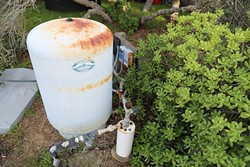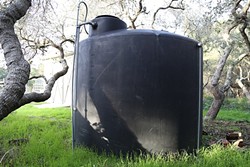[{
"name": "Ad - Medium Rectangle CC01 - 300x250",
"id": "AdMediumRectangleCC01300x250",
"class": "inlineCenter",
"insertPoint": "8",
"component": "2963441",
"requiredCountToDisplay": "12"
},{
"name": "Ad - Medium Rectangle LC01 - 300x250",
"id": "AdMediumRectangleCC01300x250",
"class": "inlineCenter",
"insertPoint": "18",
"component": "2963441",
"requiredCountToDisplay": "22"
},{
"name": "Ad - Medium Rectangle LC09 - 300x250",
"id": "AdMediumRectangleLC09300x250",
"class": "inlineCenter",
"insertPoint": "28",
"component": "3252660",
"requiredCountToDisplay": "32"
}]
The water comes out of the tap clear and cool. In the
But appearances can be deceiving. Just ask the 10—possibly more—well owners near the San Luis Obispo airport who recently found out that something potentially dangerous is lurking in their water.
It’s called trichloroethene or trichloroethylene, but most refer to it as TCE. The chemical, which is listed as a probable carcinogen, was discovered in amounts above what the Federal Environmental Protection Agency considers safe.
It started with a single well owner who noticed their water had a chemical smell. When the water was tested, TCE was discovered. A test of other nearby wells revealed TCE amounts above the EPA’s levels in four additional wells.
A week later, SLO County and state water board authorities were still investigating just how the chemical, commonly used as an industrial solvent, got into the water. There’s some speculation that it may have come from the SLO Regional Airport, which sits uphill from the area where the contamination was found. But even as officials investigate further, they are still unsure just how many wells could actually be affected. Rick Moran, a spokesman for the State Water Resources Control Board, told New Times that an additional 37 wells had been tested, and six of those contained levels of TCE beyond the EPA’s standards.
The issue continues to grow in scope, and now lawyers are involved. Several of the
And while SLO residents continue to keep an eye out for more news of TCE contaminations, the solvent isn’t the only questionable chemical found in local water supplies. At least two of those other chemicals could be connected to military installations on the Central Coast.
Emerging contaminants
So far, the presence of high levels of TCE in local wells is relegated to a small area near the airport—Buckley Road, bounded by Davenport Creek Road, Evans Road, and Thread Lane.
But two other chemicals, ones currently unregulated but considered to be “emerging contaminants” by the EPA and state officials, have also been found in water samples taken throughout the county.
They are called perfluorooctane sulfonate and perfluorooctanoic acid, or as they are more commonly referred
“As a result, they are widely distributed across the higher trophic levels and are found in soil, air, and groundwater at sites across the United States,” a 2014 EPA report on the two compounds stated. “The toxicity, mobility, and bioaccumulation potential of PFOS and PFOA pose potential adverse effects for the environment and human health.”
The EPA is still studying the health risks of exposure to high amounts of PFOA and PFOS. In 2006, the agency’s science advisory board determined that PFOA met the requirement to be designated as “likely carcinogenic” to humans. Other studies found possible links between the chemicals and everything from kidney and bladder cancer to thyroid disease, though most noted that further research was necessary.
“Studies indicate that PFOA and PFOS can cause developmental, reproductive, and other adverse effects in laboratory animals,” an EPA response to questions from New Times stated. “The most consistent findings from epidemiology studies are elevated serum total cholesterol levels among exposed populations with more limited findings related to low infant birth weights.”
The evidence was not enough for the EPA to classify PFOA or PFOS as a hazardous substance or waste. Instead, the agency issued a provisional health advisory in 2009 identifying them as “emerging contaminants.” EPA officials told New Times that the agency plans to issue a lifetime advisory on both chemicals later this year. However, advisories are simply guidelines and not standards that the agency can enforce under federal law.
“Health advisories are not enforceable federal standards,” the EPA’s statement to New Times said.
It isn’t just the EPA that’s concerned. The Reproductive Toxicant Committee of the California Office of Environmental Health Hazard Assessment is considering whether to put both chemicals on a list of substances that cause reproductive harm under the state’s Proposition 65 law.
“After considering presentations by the staff, [the committee] decided to assign both chemicals a high priority for future listing consideration,” said Sam Delson, deputy director for External and Legislative Affairs for the California OEHHA.
In our water
Both PFOA and PFOS fall under the EPA’s Third Unregulated Contaminant Monitoring Rule, or UCMR 3. Created as part of the 1996 Safe Drinking Water Act, UCMR 3 requires the EPA to issue a list of no more than 30 unregulated contaminants to be monitored by public water systems every five years. Both PFOA and PFOS are on the most recent list. Private wells aren’t required to be tested under the rule.
“It’s a way for the EPA to gather more information about those chemicals,” said Jeff Densmore, District 6 supervisor for the State Water Resources Control Board Division of Drinking Water Programs. “Typically it’s the local water utilities who take those samples.”
According to the EPA’s data, both chemicals appeared in multiple water samples taken across SLO County between 2013 and 2015. Under the monitoring rule, about 510 samples were taken and tested for the contaminants on the list. PFOA or PFOS showed up in water samples taken from all over the county, including the city of San Luis Obispo, Santa Margarita, Morro Bay, Atascadero, Paso Robles, Arroyo Grande, Grover Beach, and Nipomo. Even samples from the California Men’s Colony contained the two chemicals.
Just how much is in that water, and is it safe? In 2009, the EPA’s provisional health advisory established the presence of PFOS above 0.2 micrograms per liter and PFOA above 0.4 micrograms per liter as amounts at which “action should be taken to reduce exposure.”
The EPA’s data showed that 99 percent of all the samples in SLO County that tested positive for PFOS or PFOA were below those levels. A single sample taken in Atascadero in 2013 had PFOA equal to, but not above, the EPA’s recommendation.
It’s unknown whether those chemicals are present in SLO County’s non-public water sources, such as private wells, and in what amounts. While county environmental health officials recommend residents test their private wells once a year, there’s no law or requirement that they do so.
Even small amounts of contaminants in water could become a problem in the future, due to the effects of the state’s drought. As part of the county’s investigation into the TCE contamination, information from the SLO County Environmental Health Department’s website noted that the increased amounts could be the result of lowering water levels allowing contaminants to become more concentrated.
“According to the water board staff, it is possible that the drought may be contributing to the increase in TCE concentrations due to a decreased dilution effect,” the website stated. “Meaning TCE may represent a higher proportion of the water content in use since groundwater levels are historically low.”
Densmore, whose region includes SLO County, agreed that the drought was having an impact.
“We have seen a change in water quality in our district,” he said. “Nitrates and man-made chemicals, they’ve been
The military connection
If there are PFCs in SLO County’s water, how did they get there? The question is made all the more perplexing because PFOA is being voluntarily phased out of use, and PFOS is—according to the EPA—no longer manufactured in the United States as of 2002. However, the EPA’s rules still allow limited use of those PFCs for specific, technical uses where no alternative option is available and for existing stocks of PFC-based chemicals manufactured or imported before 2002.
A massive amount of that pre-2002 stock is held by a single entity: the United States Military.
The EPA’s reports and information on PFCs note numerous times that the chemicals, particularly PFOS, are present in Aqueous Film Forming Foam, or AFFF. The foam was developed as a way to fight fires caused by highly flammable liquids, including jet fuel. Burning at temperatures between 800 and 1,500 degrees Fahrenheit, fires from aircraft crashes and other accidents can’t be put out easily with water.
The military began widespread use of the PFOS-based foam as far back as the 1960s according to the Department of Defense’s Chemical and Material Risk Management Directorate.
“Due to their long shelf lives, legacy AFFF, including PFOS-based AFFF concentrate, may still be present in your inventory,” an alert issued by the
This “legacy” foam not only contains
The foam isn’t just used for plane crashes and explosions, which are relatively rare occurrences. It’s also used in training exercises to show military soldiers
“Although not allowed for use today, the DOD has used unlined, earthen area/basins to support live firefighting training activities,” the directorate’s alert stated. “These activities may have resulted in soil and groundwater contamination.”
The document also noted that, in addition to actual jet crashes and
In its statement to New Times, the EPA acknowledged the connection.
“There is a connection between PFC contamination and facilities or locations where fuel fires or fire training activities have occurred. Airplane crash sites, flight lines, and military fire training areas can be point sources due to the use of AFFF to extinguish the fires. This connection is apparent worldwide, not just in the U.S.,” the EPA said.
In its investigative report, The Intercept obtained a list from the DOD of active and former military installations that were fire or crash training sites. That list includes two names that SLO County residents will likely be familiar with: Camp Roberts and Vandenberg Air Force Base.
A tale of two bases
Located roughly 15 miles north of Paso Robles, Camp Roberts is a military installation with a rich history dating back to WWII. At its height as a training facility in the 1940s, an estimated 46,000 American soldiers passed through the base. The camp also saw heavy activity during the Korean and Vietnam wars before the Army closed Camp Roberts in 1970 and turned the installation over to the California National Guard, which operates the site to this day.
According to the DOD’s information, Camp Roberts is or was home to a “fire training area” as of 2014, making it a likely site where AFFF was used, and a possible site of contamination. Officials from the California National Guard said that Camp Roberts had received no requests to test soil or groundwater for the chemicals, but that the base no longer used “environmentally dangerous” firefighting foam.
Vandenberg Air Force Base, a coastal installation located 20 miles south of Santa Maria in Santa Barbara County, has a similarly rich military history. It started as an Army training center, called Camp Cooke, in 1941. The site was eventually turned over to the Air Force in 1957. Today the base is home to the 30th Space Wing’s ICBM and space missions, is the only military installation that launches unmanned government and commercial satellites into polar orbit, and is the only site from which Minuteman III intercontinental ballistic missiles (ICBMs) are launched toward the Kwajalein Atoll to verify weapon systems performance, according to the base’s website.
The DOD also listed Vandenberg as a “fire training area” as of 2014, again making it likely that the PFOS-based foam was and may still be used for firefighting and fire training exercises. Vandenberg Air Force Base officials did not respond to a request from New Times for an interview.
The Air Force, like other military branches, is aware of the issue and has been taking steps to study and mitigate possible contamination from AFFF. A memo of talking points from the Air Force Civil Engineer Center stated that the Air Force planned to begin a three-phase process to
The DOD’s Chemical and Material Risk Management Directorate’s alert advised following current standards created to contain and minimize AFFF release into the environment such as double lining the fire training pits, improving wastewater collection systems, and using
Pease AFB is a troubling example
The keen interest taken by the DOD and the other branches of the military over the PFC contamination issues isn’t surprising, especially in light of a high-profile incident in Portsmouth, N.H.
In May 2015, Portsmouth officials were forced to completely shut down a city well after PFCs were discovered in levels 10 times above those the EPA deemed safe. The site, a trade port that houses three wells, was formerly Pease Air Force Base—which, like many other bases, conducted fire training exercises using the PFOS-based foam for years. According to a 2015 report from New Hampshire television news station WMUR, nearly 10,000 people work at the trade port, and the area of contamination was also home to two
The problem could be far more widespread. According to The Intercept’s reporting, PFCs have been found in the groundwater at several bases, including the Air National Guard base in Delaware, the Grissom Air Reserve Base in Indiana, and even the Beale and McClellan Air Force bases located in California. Testing at hundreds of sites still appears to be ongoing, and the ultimate impact on nearby groundwater and communities that rely on that water, like those in SLO County, remains unknown.
So while federal, state, and military officials grapple with the questions of just how much of the chemicals are in the water and what risk they may or may not pose to humans, there is little that residents can do to mitigate the problem. Private wells and water sources can be tested and monitored. The EPA suggests that carbon filters, nanofiltration, and reverse osmosis units have been shown to remove PFCs from water, but the agency followed that assessment with a note that will likely give many
“Research for a cost-effective treatment approach for PFOS and PFOA is ongoing,” the EPA said.
Staff Writer Chris McGuinness can be reached at [email protected], or on Twitter at @CWMcGuinness.
Latest in News
Comments
Showing 1-1 of 1
Readers also liked…
-

Coast Unified teachers upset over new position's salary and qualifications
Oct 20, 2022 -

SLO police identify alleged driver who hit and killed couple
Dec 22, 2022 -

When the levee breaks: Oceano residents, county officials walk a tightrope of regulations to manage Arroyo Grande Creek, which some say led to the levee's failure in January
May 18, 2023












